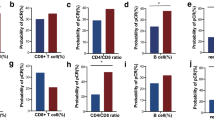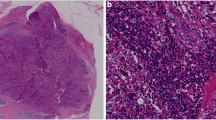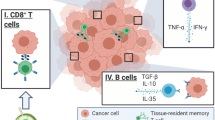Abstract
Tumor-infiltrating lymphocytes are an important prognostic factor after neoadjuvant chemotherapy (NAC) in patients with breast cancer. Natural killer (NK) cells play critical roles in antitumor immune surveillance. Here, we assessed the relationship between peripheral natural killer (pNK) cell activity, tumor microenvironmental factors (TMEFs), and the therapeutic efficacy of preoperative chemotherapy in patients with breast cancer. In a cohort of 39 patients diagnosed with stage II–IV breast cancer who received NAC, we measured pNK cell activity by chromium release assay and assessed TMEF levels by next-generation sequencing. Following NAC, pNK cell activity was increased in 24/39 patients but decreased in 15/39 patients. Increased pNK cell activity following preoperative chemotherapy was associated significantly with the disappearance of axillary lymph node metastasis (Ax+; p = 0.0235). Increased pNK cell activity remained significantly associated with the disappearance of Ax+ in multivariate logistic regression analysis (OR 5.41, 95% CI 1.19–24.52, p = 0.0283). A Grade 2 or higher effect of NAC was associated with high pre-NAC cytotoxic T lymphocyte-associated protein 4 (CTLA-4) levels (p = 0.0281) and elevated post-NAC NK (p = 0.0005) cells and transforming growth factor-beta (TGF-β; p = 0.0350) levels. The disappearance of Ax+ was associated with high pre-NAC CTLA-4 levels (p = 0.0278) and elevated CD4 levels after NAC (p = 0.0250). The systemic activation of pNK cells after NAC may improve metastatic tumor elimination in patients with breast cancer owing to a release from local immunosuppression, and immune activation in the tumor microenvironment.

Similar content being viewed by others
Abbreviations
- Ax+:
-
Axillary lymph node metastasis
- CI:
-
Confidence interval
- CTLA-4:
-
Cytotoxic T lymphocyte-associated protein 4
- DTX:
-
Docetaxel
- FEC:
-
5-Fluorouracil/epirubicin/cyclophosphamide
- FFPE:
-
Formalin-fixed paraffin embedded
- HER-2:
-
Human epidermal growth factor receptor-2
- Nab-PTX:
-
Nanoparticle albumin-bound-paclitaxel
- NAC:
-
Neoadjuvant chemotherapy
- OR:
-
Odds ratio
- pNK:
-
Peripheral natural killer
- TMEF:
-
Tumor microenvironmental factor
- TN:
-
Triple negative
- Tz:
-
Trastuzumab
References
Denkert C, von Minckwitz G, Darb-Esfahani S, Lederer B, Heppner BI, Weber KE, Budczies J, Huober J, Klauschen F, Furlanetto J, Schmitt WD, Blohmer JU, Karn T, Pfitzner BM, Kümmel S, Engels K, Schneeweiss A, Hartmann A, Noske A, Fasching PA, Jackisch C, van Mackelenbergh M, Sinn P, Schem C, Hanusch C, Untch M, Loibl S (2018) Tumour-infiltrating lymphocytes and prognosis in different subtypes of breast cancer: a pooled analysis of 3771 patients treated with neoadjuvant therapy. Lancet Oncol 19:40–50. https://doi.org/10.1016/S1470-2045(17)30904-X
Shanker A, Marincola FM (2011) Cooperativity of adaptive and innate immunity: implications for cancer therapy. Cancer Immunol Immunother 60:1061–1074. https://doi.org/10.1186/1479-5876-11-145
Seo AN, Lee HJ, Kim EJ, Kim HJ, Jang MH, Lee HE, Kim YJ, Kim JH, Park SY (2013) Tumour-infiltrating CD8+ lymphocytes as an independent predictive factor for pathological complete response to primary systemic therapy in breast cancer. Br J Cancer 109:2705–2713. https://doi.org/10.1038/bjc.2013.634
Verma C, Kaewkangsadan V, Eremin JM, Cowley GP, Ilyas M, El-Sheemy MA, Eremin O (2015) Natural killer (NK) cell profiles in blood and tumour in women with large and locally advanced breast cancer (LLABC) and their contribution to a pathological complete response (PCR) in the tumour following neoadjuvant chemotherapy (NAC): differential restoration of blood profiles by NAC and surgery. J Transl Med 13:180. https://doi.org/10.1186/s12967-015-0535-8
Muraro E, Comaro E, Talamini R, Turchet E, Miolo G, Scalone S, Militello L, Lombardi D, Spazzapan S, Perin T, Massarut S, Crivellari D, Dolcetti R, Martorelli D (2015) Improved Natural Killer cell activity and retained anti-tumor CD8(+) T cell responses contribute to the induction of a pathological complete response in HER2-positive breast cancer patients undergoing neoadjuvant chemotherapy. J Transl Med 13:204. https://doi.org/10.1186/s12967-015-0567-0
Brierley JD, Gospodarowicz MK, Wittekind C (eds) (2017) TNM classification of malignant tumours, 8th edn. Wiley-Blackwell, Hoboken
Kurosumi M (2006) Significance and problems in evaluations of pathological responses to neoadjuvant therapy for breast cancer. Breast Cancer 13:254–259. https://doi.org/10.2325/jbcs.13.254
Rouzier R, Extra JM, Klijanienko J, Falcou MC, Asselain B, Vincent-Salomon A, Vielh P, Bourstyn E (2002) Incidence and prognostic significance of complete axillary downstaging after primary chemotherapy in breast cancer patients with T1 to T3 tumors and cytologically proven axillary metastatic lymph nodes. J Clin Oncol 20:1304–1310
Diaz-Botero S, Espinosa-Bravo M, Gonçalves VR, Esgueva-Colmenarejo A, Peg V, Perez J, Cortes J, Rubio IT (2016) Different prognostic implications of residual disease after neoadjuvant treatment: Impact of Ki 67 and site of response. Ann Surg Oncol 23:3831–3837
Hayashi N, Takahashi Y, Matsuda N, Tsunoda H, Yoshida A, Suzuki K, Nakamura S, Yamauchi H (2018) The prognostic effect of changes in tumor stage and nodal status after neoadjuvant chemotherapy in each primary breast cancer subtype. Clin Breast Cancer 18:e219–e229. https://doi.org/10.1016/j.clbc.2017.09.013
Slaney CY, Rautela J, Parker BS (2013) The emerging role of immunosurveillance in dictating metastatic spread in breast cancer. Cancer Res 73:5852–5857. https://doi.org/10.1158/0008-5472.CAN-13-1642
Mamessier E, Sylvain A, Thibult ML, Houvenaeghel G, Jacquemier J, Castellano R, Gonçalves A, André P, Romagné F, Thibault G, Viens P, Birnbaum D, Bertucci F, Moretta A, Olive D (2011) Human breast cancer cells enhance self tolerance by promoting evasion from NK cell antitumor immunity. J Clin Invest 121:3609–3622. https://doi.org/10.1172/JCI45816
Pickup M, Novitskiy S, Moses HL (2013) The roles of TGFβ in the tumour microenvironment. Nat Rev Cancer 13:788–799. https://doi.org/10.1038/nrc3603
Kerdiles Y, Ugolini S, Vivier E (2013) T cell regulation of natural killer cells. J Exp Med 210:1065–1068. https://doi.org/10.1084/jem.20130960
Ghiringhelli F, Menard C, Terme M, Flament C, Taieb J, Chaput N, Puig PE, Novault S, Escudier B, Vivier E, Lecesne A, Robert C, Blay JY, Bernard J, Caillat-Zucman S, Freitas A, Tursz T, Wagner-Ballon O, Capron C, Vainchencker W, Martin F, Zitvogel L (2005) CD4+ CD25+ regulatory T cells inhibit natural killer cell functions in a transforming growth factor-beta-dependent manner. J Exp Med 202:1075–1085
Spitzer MH, Carmi Y, Reticker-Flynn NE, Kwek SS, Madhireddy D, Martins MM, Gherardini PF, Prestwood TR, Chabon J, Bendall SC, Fong L, Nolan GP, Engleman EG (2017) Systemic immunity is required for effective cancer immunotherapy. Cell 168:487–502. https://doi.org/10.1016/j.cell.2016.12.022
Acknowledgements
The authors thank the patients and their families for their participation in the study. The authors also thank SRL. Inc. (Tokyo, Japan) for the measurement of pNK cell activity.
Funding
No specific funding was received for this study.
Author information
Authors and Affiliations
Contributions
Conception and design: RK. Collection and assembly of data: RK, AK, MW, YF, NY, MH, YM, SO, MI, KA. Data analysis and interpretation: RK, AK, MH, YM. Manuscript writing: RK, YM. Final approval of manuscript: all authors.
Corresponding author
Ethics declarations
Conflict of interest
The authors declare that they have no conflicts of interest.
Ethical approval
This study was approved by the research ethics committee of the Hiroshima Mark Clinic on July 1, 2012. All procedures performed in studies involving human participants were in accordance with the ethical standards of the institutional and/or national research committee and with the 1964 Helsinki declaration and its later amendments or comparable ethical standards.
Informed consent
Informed consent was obtained from all individual participants included in the study.
Rights and permissions
About this article
Cite this article
Kim, R., Kawai, A., Wakisaka, M. et al. A potential role for peripheral natural killer cell activity induced by preoperative chemotherapy in breast cancer patients. Cancer Immunol Immunother 68, 577–585 (2019). https://doi.org/10.1007/s00262-019-02305-z
Received:
Accepted:
Published:
Issue Date:
DOI: https://doi.org/10.1007/s00262-019-02305-z




